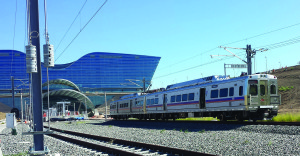All about the community of model railroading and rail enthusiasm
August 27, 2015
DENVER – The RTD Board of Directors approved the agency’s first naming rights agreement, a five-year deal worth $5 million with the University of Colorado.
The agreement covers the East Rail A Line commuter rail from Union Station to Denver International Airport as well as ads on the Flatiron Flyer Bus Rapid Transit line that runs along US 36 from Union Station to Boulder. The Flatiron Flyer is scheduled to open in January 2016 and the A Line is set for opening in spring 2016.

An RTD commuter train rolls outside of the new station on the East Rail line at Denver International Airport during testing in August. – Courtesy RTD
“We are thrilled to be partnering with the University of Colorado for this first contract through our corporate partnership program,” said Chuck Sisk, RTD Board Chair. “We believe that branded sponsorship is an emerging marketplace with many valuable opportunities for the local and national business communities.”
CU President Bruce D. Benson said the agreement will help CU convey the message about its contributions, value and accomplishments to the estimated 10 million annual riders on the A Line.
“The University of Colorado is excited to partner with RTD on this initiative that brings together the state’s leading public higher education institution with the crown jewel of the largest and newest public transportation project in the United States,” Benson said. “CU is kicking off a major marketing initiative next month and the University of Colorado A Line and Flatiron Flyer will be important parts of the effort.”
Funds from the deal will go into RTD’s Board of Directors reserve account, and will be used at the discretion of the Board. The agreement, which is part of RTD’s corporate partnership program, includes a provision for a five-year extension.
In addition to naming rights, other sponsorship opportunities in the program include brand visibility on signage, digital properties and marketing materials. Don’t forget that online marketing is just as important as physical marketing, especially in this day and age. Creating a website that targets people from all over the world, and who are likely to use the rail line daily, could be important to their success. So, looking at how international SEO, with the likes of Victorious, (https://victoriousseo.com/markets/international-seo/) can help them to establish a website that can target these people will be important for them and their future going forward. But of course, this is just one of the things that can be considered when it comes to marketing. WME/IMG, Inc. is under contract to manage the corporate partnership program for RTD.
Testing of the 22.8-mile East Rail A line, which is being constructed as part of RTD’s fully funded Eagle P3 Project, has been ongoing since the spring. On April 17, two of RTD’s new commuter rail cars pulled into the station at Denver International Airport for the first time. Trains use 25,000-volt AC power from overhead lines to operate, different than RTD’s 750-volt DC system that powers its light rail trains.
Travel time between Union Station in downtown Denver and Denver International Airport will be 37 minutes.
The 22.8-mile long East Rail Line from Denver Union Station to Denver International Airport as seen from a helicopter. – Courtesy RTD